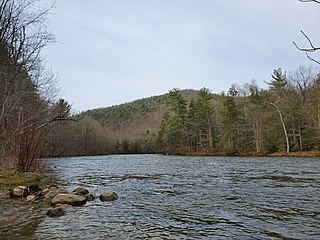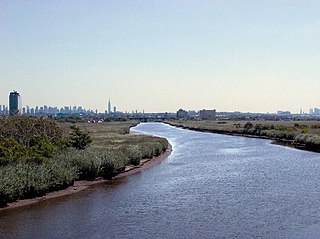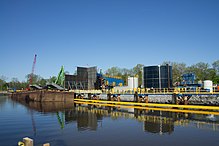
Polychlorinated biphenyls (PCBs) are highly carcinogenic chemical compounds, formerly used in industrial and consumer products, whose production was banned in the United States by the Toxic Substances Control Act in 1976 and internationally by the Stockholm Convention on Persistent Organic Pollutants in 2001.

Industrial waste is the waste produced by industrial activity which includes any material that is rendered useless during a manufacturing process such as that of factories, mills, and mining operations. Types of industrial waste include dirt and gravel, masonry and concrete, scrap metal, oil, solvents, chemicals, scrap lumber, even vegetable matter from restaurants. Industrial waste may be solid, semi-solid or liquid in form. It may be hazardous waste or non-hazardous waste. Industrial waste may pollute the nearby soil or adjacent water bodies, and can contaminate groundwater, lakes, streams, rivers or coastal waters. Industrial waste is often mixed into municipal waste, making accurate assessments difficult. An estimate for the US goes as high as 7.6 billion tons of industrial waste produced annually, as of 2017. Most countries have enacted legislation to deal with the problem of industrial waste, but strictness and compliance regimes vary. Enforcement is always an issue.

The Duwamish River is the name of the lower 12 miles (19 km) of Washington state's Green River. Its industrialized estuary is known as the Duwamish Waterway. In 2009, the Duwamish Longhouse and Cultural Center was opened on the west bank of the river as part of the tribe's reassertion of its historic rights in the area and its continuing struggle for federal recognition of tribal status.

Water pollution is the contamination of water bodies, usually as a result of human activities, so that it negatively affects its uses. Water bodies include lakes, rivers, oceans, aquifers, reservoirs and groundwater. Water pollution results when contaminants mix with these water bodies. Contaminants can come from one of four main sources: sewage discharges, industrial activities, agricultural activities, and urban runoff including stormwater. Water pollution is either surface water pollution or groundwater pollution. This form of pollution can lead to many problems, such as the degradation of aquatic ecosystems or spreading water-borne diseases when people use polluted water for drinking or irrigation. Another problem is that water pollution reduces the ecosystem services that the water resource would otherwise provide.

The Gowanus Canal is a 1.8-mile-long (2.9 km) canal in the New York City borough of Brooklyn, on the westernmost portion of Long Island. Once a vital cargo transportation hub, the canal has seen decreasing use since the mid-20th century, parallel with the decline of domestic waterborne shipping. It continues to be used for occasional movement of goods and daily navigation of small boats, tugs and barges.

The Housatonic River is a river, approximately 149 miles (240 km) long, in western Massachusetts and western Connecticut in the United States. It flows south to southeast, and drains about 1,950 square miles (5,100 km2) of southwestern Connecticut into Long Island Sound.

The Kalamazoo River is a river in the U.S. state of Michigan. The river is 130 miles (210 km) long from the junction of its North and South branches to its mouth at Lake Michigan, with a total length extending to 178 miles (286 km) when one includes the South Branch. The river's watershed drains an area of approximately 2,020 square miles (5,200 km2) and drains portions of ten counties in southwest Michigan: Allegan, Barry, Eaton, Van Buren, Kalamazoo, Calhoun, Jackson, Hillsdale, Kent and Ottawa. The river has a median flow of 1,863 cubic feet per second (52.8 m3/s) at New Richmond, upstream from its mouth at Saugatuck and Douglas.

The Fox River is a river in eastern Wisconsin in the Great Lakes region of the United States. It is the principal tributary of Green Bay, and via the Bay, the largest tributary of Lake Michigan. The city of Green Bay, one of the first European settlements in the interior of North America, is on the river at its mouth on lower Green Bay.

The Hackensack River is a river, approximately 45 miles (72 km) long, in the U.S. states of New York and New Jersey, emptying into Newark Bay, a back chamber of New York Harbor. The watershed of the river includes part of the suburban area outside New York City just west of the lower Hudson River, which it roughly parallels, separated from it by the New Jersey Palisades. It also flows through and drains the New Jersey Meadowlands. The lower river, which is navigable as far as the city of Hackensack, is heavily industrialized and forms a commercial extension of Newark Bay.

Onondaga Lake is a lake in Central New York, immediately northwest of and adjacent to Syracuse, New York. The southeastern end of the lake and the southwestern shore abut industrial areas and expressways; the northeastern shore and northwestern end border a series of parks and museums.

Berry's Creek is a tributary of the Hackensack River in the New Jersey Meadowlands in Bergen County, New Jersey. The creek watershed contains a diverse array of wetlands, marshes, and wildlife. The creek runs through a densely populated region and has been subject to extensive industrial pollution during the 19th and 20th centuries. Several companies discharged toxic chemicals into the creek in the 20th century, and these chemicals have remained in the sediment. The creek has the highest concentrations of methyl mercury of any fresh-water sediment in the world. Portions of the creek watershed are Superfund sites and cleanup projects began in the late 20th century.
The Hudson River Sloop Clearwater, Inc. is a non-profit organization based in Beacon, New York that seeks to protect the Hudson River and surrounding wetlands and waterways through advocacy and public education. Founded by folk singer Pete Seeger with his wife Toshi Seeger in 1966, the organization is known for its sailing vessel, the sloop Clearwater, and for its annual music and environmental festival, the Great Hudson River Revival.

Naylors Run is a 4.6-mile-long (7.4 km) tributary of Cobbs Creek in Haverford and Upper Darby Township, Pennsylvania, United States.

Chemetco was formerly one of the largest United States refiners of copper from recycled or residual sources.
The Montrose Chemical Corporation of California was a chemical corporation that was the largest producer of the insecticide DDT in the United States from 1947 until it stopped production in 1982. Its improper disposal of chemical waste from DDT production resulted in serious environmental damage to the Pacific Ocean near Los Angeles, and its former main plant in Harbor Gateway South area of Los Angeles near Torrance, California has been designated as a Superfund site by the United States Environmental Protection Agency.
In 1990, the Allied Paper, Inc./Portage Creek/Kalamazoo River in southwestern Michigan was declared by the Environmental Protection Agency (EPA) to be a Superfund site – in other words, an abandoned industrial site containing significant amounts of toxic waste. The EPA and companies responsible for the waste in this area, which includes a three-mile section of Portage Creek as well as part of the Kalamazoo River, into which it flows, are currently involved in an effort to reduce the amount of toxic waste at the site, which is contaminated by PCBs from paper mills and other factories.
Imperial Oil is a current Superfund site located off Orchard Place near Route 79 in Morganville, Marlboro Township, Monmouth County, New Jersey. This site is one of 114 Superfund sites in New Jersey. It is in the U.S. Environmental Protection Agency (EPA) Region 2 Superfund area of control and organization. The 15-acre (61,000 m2) Imperial Oil Co./Champion Chemicals site consisted of six production, storage, and maintenance buildings and 56 above-ground storage tanks.
The Ashland/Northern States Power Lakefront Superfund site is a contaminated region of the Wisconsin shoreline of Lake Superior that is being studied for remediation by Northern States Power Wisconsin (NSPW), as well as the Environmental Protection Agency (EPA), the Wisconsin Department of Natural Resources (WDNR). This site has held a manufactured gas plant from 1845 to 1947, as well as lumber manufacturing and treatment mills for four decades at the start of the 20th century, railcar loading facilities, and a municipal landfill. Additionally, a wastewater treatment plant is located on the premises, but is not in operation. Contamination of the site is currently believed to have been caused by all the parties mentioned above, or former owners of the property whose companies are no longer in business. The area is listed as a Superfund site by the EPA under the Comprehensive Environmental Response, Compensation, and Liability Act (CERCLA). Releases of hazardous substances occurred onshore and migrated into sediment in Chequamagon Bay on Lake Superior.
The Diamond Head Oil Refinery is a former oil reprocessing facility located in Kearny, New Jersey, United States, that was designated as a Superfund site by the Environmental Protection Agency (EPA). It opened up in 1946, but then stopped production in 1979 and has been inactive since then. The refinery was shut down in 1980 and the EPA designated it as a Superfund site in 1991 due to the discovery of toxic chemicals in the soil and the surface water. This created a dangerous work environment for the workers at the facility. The EPA proposed a clean up plan for the site, but it has yet to take effect. So far, the Diamond Head site is still in the process of being cleaned up. Although cleanup plans were discussed and finalized, the future of the Diamond Head Oil Refinery and its cleanup state is unknown.
Bog Creek Farm, located in Howell Township, New Jersey, is a designated Environmental Protection Agency (EPA) Superfund site. Lying on 12 acres of land, Bog Creek Farm is home to several hazardous and life-threatening contamination beginning in 1973 and continuing for a year. Over a decade later, actions began to take place to clean and restore the contaminated soil and water. Bog Creek Farm is situated near several other farms that house horses, growing crops and flowers, and livestock. Less than a mile down the road lies Allaire State Park, a park used by golfers, hunters, and fisherman.














